Gulf of Aden: An exciting transit with welcome support (April 2016)
In April 2016 SY Sea Child sailed from the Maldive Islands into the Red Sea. This report is notable, not only for the routing they took and the exhilarating sail they had but also for the extent of the support they received from the military coalition forces.
Published 5 years ago
Introduction
So much has been written about the Gulf of Aden (GOA), a body of water that separates the Arabian Peninsula of Asia and the African Continent. Some stories are scary and dangerous (piracy) and some stories are treacherous (weather). During the NE monsoon season, winds are prevailing from the E to ENE, which is exactly the season to sail from Socotra Island to Bab el Mandeb at the southern mouth of the Red Sea. Sea Child’s crossing of the GOA was fast, busy, and certainly in good company.
We had been reporting our position daily to UKMTO, a Dubai organization that represents a security coalition of nations (India, China, Japan, Korea, EU) daily at 080 UTC since our departure from the Maldives. This sense of security was welcome on board, giving us at least some comfort that others were paying attention to our location, speed, course, and destinations. This was a part of our daily tasks aboard Sea Child as we sailed down the GOA.
Upon initial contact with UKMTO, we were advised to join a convoy since we were sailing the GOA without hired security on board. The requirements to join the slowest convoy was that we had to maintain a boat speed of 10kts under power, and meet at a specific position at a specific time. This convoy option was not possible for Sea Child as we could not guarantee that we could maintain the required speeds. The following is a detailed look at our 3 3/4 day passage of the Gulf of Aden:
Day 1
Monday, March 28, 2016, 12:30pm-Tuesday March 29, 2016 Noon. Days run 182nms.
We departed Socotra Island at 12:30 pm and set a course of 290°, which would take us more northerly towards the security lanes (IRTC), that had been established for commercial traffic transiting the GOA. There are specific entry points into the lanes (position A or position B) and we were headed towards the east entry lane, located at 14° 26” 09’N, 53°, 00”19’ E. From the west end of Socotra, this entry location was due north, so sailing a course of 290° would have us intersect the security corridor about 174nms from Socotra Island. The winds at our departure were gusting to well over 25kts, having us sail under full main alone as we surfed down the wind waves towards the shadow of Socotra. Once there, around sunset, we spotted a few anchored fishing boats who we believe were, from Socotra Island. They waved as we sailed on by. Throughout the night, we were sailing a more northerly course, around 335° to keep the wind angle at 60°-70°, which was fine by me since it brought us closer to the security lanes earlier than the 290° course. We did not pick up any AIS vessels until we were within about 20nms of the IRTC.
During Eric’s late watch, (2 am -6 am), he had jibed us onto a course of 270° as we motor sailed making water, winds ESE 8 kts. When I came up for my 0600-1000hr watch & realized how far south we were from the IRTC, I became concerned. We were sailing in an area between the lanes and the Horn of Africa, and I felt that if we were closer to the shipping lanes we would be safer.
Day 2
Tuesday, March 29, 2016, Noon-Wednesday March 30, 2016 Noon, Days Run 182nms.
Around 1400hrs, a Japanese surveillance plane flew over Sea Child, and within a minute the Japanese Navy contacted us on VHF Ch16. By this time, we had picked up several ships on AIS and the Japanese Navy asked us if we needed any assistance, was there anything they could do for us, have we seen any suspicious activity? If so, they are always standing by on VHF Ch16. Eric asked them where they were, as we could not see them on AIS? They stated that they receive but do not transmit. Sounds logical. The seas were 1′-3′ following us, winds ESE at 10kts and we were making about 7.5kts boat speed under full main and screecher. We were now 2.8nms SSE of the IRTC.
During our dinner, we had an EU Warship on our port (see photo right), and they sailed with us for about two hours before turning S towards the Horn ofYemen EU WarshipAfrica. We had cleared the wind shadow of Socotra Island and were now being 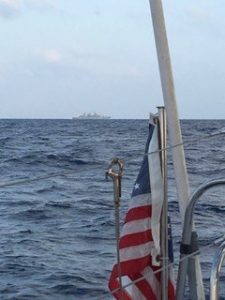

Our 4 hours on, 4 hours off watch was taking adventure travel to a whole new level of stamina, so any amount of sleep, even a short nap, was much needed and somewhat refreshing though we were both so exhausted. We were now 400nms to Bab El Mandeb and had just entered the HRA (High-Risk Area), an area between 49° and 46° E. We noticed the Indian Navy sailing with a large group of AIS targets, heading east, about 10nms from our location. Another security check for us that again made our passage feel much safer. We could focus on sailing Sea Child, sending in our daily UKMTO positions, maintaining systems and provisions, monitoring batteries, fuel consumption, and of course, trying to get any sleep we could.
By sunrise, we were 115nms N of Somalia, 92nms S of Yemen, seas 5′-6′, winds 19-20kts ESE, 9kts boat speed, course 242°. We sailed deep downwind with main alone, as the waves began stacking up behind us, close together and very steep. We were now close enough to the IRTC that we could see the giant commercial ships as they headed eastbound. Super huge tankers and freighters went by, some in convoys of 5-7 ships, some alone. We heard the EU warship contact one of the eastbound ships, asking them why the ship did not have their AIS turned on? The ship replied that they were not in a convoy and that their captain had the AIS off until out of the HRA. The EU Warship told them that they were safe, please turn on the AIS, and again, the ship denied the warship request. The ship was then questioned at length about details, last port, next port, cargo, personnel, tonnage, etc. After a few minutes of talking back and forth, the EU warship was standing by on VHF Ch16.
Day 3
Wednesday, March 30, 2016 noon – Thursday, March 31, 2016 noon. Days run 210nms.
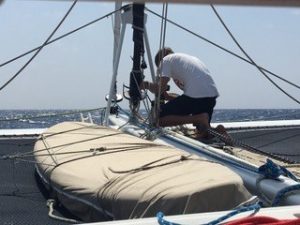

As Sea Child sailed downwind in the GOA, the bows rising on each steep wave, dropping into the troughs and picking up speed, then rising again, Eric held a drill just perfect into the set screw holes and re-drilled them, then reset the screws in a tighter puka (hole) so that they would not back out again. We were now sailing hard and fast deeper in the GOA, and would definitely need the roller furling system on the jib to work properly as we neared the Bab el Mandeb straights into the Red Sea.
By dinner on Wednesday night, we again had company join us as we sailed deeper into the HRA/GOA. This time, we picked up a Japanese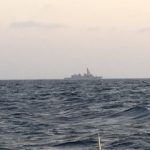

We were sailing a course of 252°, hand steering at this point to maintain course and speed, Sea Child surfing along at 8kts. Waves would pick us up and knock us around, and as we sailed closer to Bab el Mandeb, we heard strange noises on the VHF, people making catcalls and playing random music. By 0100hrs on Thursday morning, we had finally sailed out of the HRA, a nice feeling at the right time of day. UKMTO had mentioned to us in an email that the highest probability for piracy encounters was either at dawn or at dusk. We were fortunate to have the two escorts with us at dinner and send sincere thanks to both EU and Japanese warships for their presence during our sail through the HRA.
By noon on Thursday, we had sailed a total of 501nms since leaving Socotra Island and had about another 158nms to Bab El Mandeb. We again changed sails from the jib to the screecher and another Japanese surveillance plane flew out of the clouds overhead Sea Child. They again called us on VHF Ch16, asked the same questions as before, and this time I told them we were fine on board and thanked them for their security presence in the GOA.
Day 4
Thursday, March 31, 2016 noon – Friday, April 1, 2016 noon. Days Run 170nms.
Our course to Bab El Mandeb now was 280°, which would have us cross the IRTC lanes and sail on the Yemen side of the corridor. Winds were ENE 12-14kts, seas 2-5’, sunny skies. We were sailing with the full main and screecher on a starboard tack and crossed the lanes with no problem. As the day wore on, the winds began to increase and the waves continued to stack 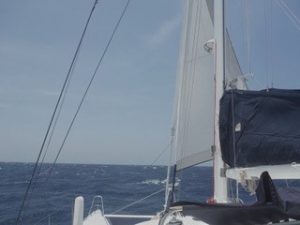

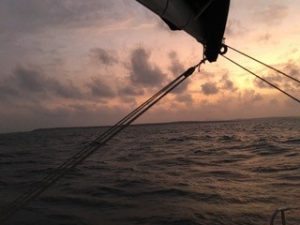

Summary
In summary, Sea Child sailed the 659 NM from Socotra Island to Bab el Mandeb in 89 hours, average boat speed 7.4kts. With the rush at the entry to the Red Sea, we had thought that we would have averaged better speed. It was a safe, busy, exhausting passage. Thankfully, the security of the UKMTO Coalition of Nations, including Indian, Korean, Japanese, EU, Chinese and Coalition warships kept the GOA passage safe and secure. Given the weather conditions of the passage as well as the security of the warships and onboard security guards listed on several AIS vessels, we could not even imagine a pirate attempting to overtake a vessel. Hopefully, those pirate days in the GOA are all in the past, and all we will read about them will be in the history books. Sea Child had a successful passage of the GOA. Now, the challenges of the Red Sea lay ahead of us.

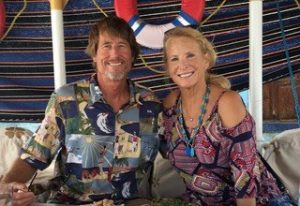
- Tamara and Eric, SY Sea Child
The opinions expressed in this article are the author’s own and do not reflect the view of noonsite.com or the World Cruising Club.
Related to the following Cruising Resources: Gulf of Aden / Indian Ocean / Red Sea, Indian Ocean, Piracy & Security, Piracy-Related Organisations and Websites, Red Sea, Routing


